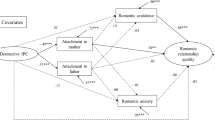Abstract
Although romantic involvement in adulthood has generally been associated with enhanced well-being, some aspects of adults’ romantic relationships (e.g., maladaptive conflict behaviors) have been linked with depressive symptoms. In order to better understand the role of romantic involvement in well-being, the present study examined links among attachment orientations, conflict behaviors with romantic partners, and depressive symptoms in an undergraduate sample of young adults (N = 110). Correlational analyses generally supported the hypothesized links. When a regression series was applied to the data in order to determine whether young adults’ conflict behaviors serve as a mediator in the link between their attachment orientations and depressive symptoms, mediation was not supported. Instead, results supported a model wherein attachment orientations and conflict behaviors (attacking) were independent predictors, explaining unique variance in young adults’ depressive symptoms. Findings underscore the importance of considering specific aspects of young adults’ romantic relationships in the prediction of their depressive symptoms and illuminate the role attachment orientations and conflict behaviors in their depressive symptoms.

Similar content being viewed by others
References
Ainsworth, M. D. S., Blehar, M. C., Waters, E., & Wall, S. (1978). Patterns of attachment: A psychological study of the strange situation. Hillsdale, NJ: Erlbaum.
Baron, R. M., & Kenny, D. A. (1986). The moderator-mediator variable distinction in social psychological research: Conceptual, strategic, and statistical considerations. Journal of Personality and Social Psychology, 51, 1173–1182.
Bowlby, J. (1969/1982). Attachment and loss: Vol. 1. Attachment. New York: Basic Books.
Bowlby, J. (1980). Attachment and loss: Vol. 3. Loss. New York: Basic Books.
Brown, G. W., & Harris, T. O. (1978). Social origins of depression. London/New York: Tavistock/Free Press.
Campbell, L., Simpson, J. A., Boldry, J., & Kashy, D. A. (2005). Perceptions of conflict and support in romantic relationships: The role of attachment anxiety. Journal of personality and social psychology, 88, 510–531.
Collins, N. L., & Read, S. J. (1990). Adult attachment, working models, and relationship quality in dating couples. Journal of Personality and Social Psychology, 58, 644–663.
Creasey, G. (2002). Associations between working models of attachment and conflict management behavior in romantic couples. Journal of Counseling Psychology, 49, 365–375.
Davila, J., Steinberg, S. J., Kachadourian, L., Cobb, R., & Fincham, F. (2004). Romantic involvement and depressive symptoms in early and late adolescence: The role of a preoccupied relational style. Personal Relationships, 11, 161–178.
Feeney, J. A., Noller, P., & Callan, V. J. (1994). Attachment style, communication and satisfaction in the early years of marriage. In K. Bartholomew & D. Perlman (Eds.), Advances in personal relationships: Vol. 5. Attachment processes in childhood (pp. 269–308). London: Jessica Kingsley.
Gjerde, P. F., & Westenberg, P. M. (1998). Dysphoric adolescents as young adults: A prospective study of the psychological sequelae of depressed mood in adolescence. Journal of Research on Adolescence, 8, 377–402.
Gottman, J. M. (1994). Why marriages succeed or fail. NY: Simon & Schuster.
Hazan, C., & Shaver, P. (1987). Romantic love conceptualized as an attachment process. Journal of Personality and Social Psychology, 52, 511–524.
Hinchcliffe, M. K., Hooper, D., & Roberts, F. J. (1978). The melancholy marriage. Toronto: Wiley.
Kobak, R. R., & Duemmler, S. (1994). Attachment and conversation: Toward a discourse analysis of adolescent and adult security. In K. Bartholomew & D. Perlman (Eds.), Attachment processes in adulthood (pp. 121–149). London: Kingsley.
Kobak, R. R., & Hazan, C. (1991). Attachment in marriage: Effects of security and accuracy of working models. Journal of Personality and Social Psychology, 60, 861–869.
Marchand, J. F. (2004). Husbands’ and wives’ marital quality: The role of adult attachment orientations, depressive symptoms, and conflict resolution behaviors. Attachment and Human Development, 6, 99–112.
Marchand, J. F., & Hock, E. (2000). Avoidance and attacking conflict-resolution strategies among married couples: Relations to depressive symptoms and marital satisfaction. Family Relations, 49, 201–206.
Nelson, G. M., & Beach, S. R. (1990). Sequential interaction in depression: Effects of depression behavior on spousal aggression. Behavior Therapy, 21, 167–182.
Nolen-Hoeksema, S. (1990). Sex Differences in depression. Standford, CA: Stanford University Press.
Pistole, M. C. (1989). Attachment in adult romantic relationships: Style of conflict and relationship satisfaction. Journal of Social and Personal Relationships, 6, 505–510.
Radloff, L. S. (1977). The CES-D Scale: A self-report depression scale for research in the general population. Applied Psychological Measurement, 1, 385–401.
Reese-Weber, M. J., & Bartle-Haring, S. E. (1998). Conflict-resolution styles in family subsystems and adolescents romantic relationships. Journal of Youth and Adolescence, 27, 735–752.
Reese-Weber, M., & Marchand, J. F. (2002). Family and individual predictors of late adolescents’ romantic relationships. Journal of Youth and Adolescence, 31, 197–206.
Rubenstein, J. L., & Feldman, S. S. (1993). Conflict-resolution behavior in adolescent boys: Antecedents and adaptational correlates. Journal of Research on Adolescence, 3, 41–66.
Sabatelli, R. M., & Bartle, S. E. (1995). Approaches to assessment of family functioning: Conceptual, operational, and analytical issues. Journal of Marriage and Family, 57, 1025–1039.
Schmaling, K. B., & Jacobson, N. S. (1990). Marital interaction and depression. Journal of Abnormal Psychology, 99, 229–236.
Shantz, C. U., & Hartup, W. W. (1992). Conflict in child and adolescent development. New York: Cambridge University Press.
Shi, L. (2003). The association between adult attachment styles and conflict resolution in romantic relationships. The American Journal of Family Therapy, 31, 143–157.
Simpson, J., & Rholes, R. (1998). Attachment theory and close relationships. New York: Guilford Press.
Umberson, D., & Williams, K. (1999). Family status and mental health. In C. S. Aneshensel & J. C. Phelan (Eds.), Handbook of the sociology of mental health (pp. 225–253). New York: Kluwer/Plenum.
Author information
Authors and Affiliations
Corresponding author
Rights and permissions
About this article
Cite this article
Marchand-Reilly, J.F. Depressive Symptoms in Young Adults: The Role of Attachment Orientations and Romantic Relationship Conflict. J Adult Dev 16, 31–38 (2009). https://doi.org/10.1007/s10804-009-9049-z
Published:
Issue Date:
DOI: https://doi.org/10.1007/s10804-009-9049-z




